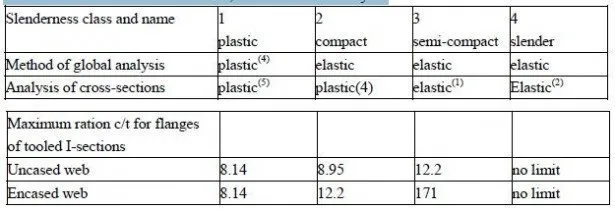Cracking of concrete
The lower surface of the slab is protected by the sheeting. Cracking will occur in the top surface where the slab is continuous over a supporting beam, and will be wider if each span of the slab is designed as simply-supported, rather than continuous, and if the spans are propped during construction.
For these reasons, longitudinal reinforcement should be provided above internal supports. The minimum amounts are given by Eurocode 4 as 0.2% of the area of concrete above the sheeting, for unpropped construction, and 0.4% if propping is used. These amounts exceed that specified in the British code, but even they may not ensure that crack widths do not exceed 0.3 mm. If the environment is corrosive (e.g, de-icing salt on the floor of a parking area), the slabs should be designed as continuous, with cracking controlled in accordance with Eurocode 2 (or an equivalent national code).
Deflection
Where composite slabs are designed as simply-supported and are not hidden by false ceilings, deflection may govern design. The maximum acceptable deflection is more a matter for the client than the designer; but if predicted deflections are large, the designer may have to allow for the extra weight of concrete in floors that are cast with a horizontal top surface, and provide clearance above non-structural partitions.
Eurocode 4 gives the following guidance. The deflection of sheeting due to its own weight and the wet concrete slab should not exceed L/180 or 20 mm, where L is the effective span. This span can be reduced to any desired level by using propped construction but this increases cost.
For the in-service situation, the rare loading combination is normally used. The maximum deflection below the level of the supports should not exceed span/250, and the increase of deflection after construction (due to creep and to variable load) should not exceed span/300, or span/350 if the floor supports brittle finishes or partitions. The Eurocode states that when verifying the composite slab, the deflection defined in the previous paragraph, above, need not be included.
For a 4-m span, this suggests that the total deflection could be
20+400/250=36mm
which would certainly be noticeable in practice.
It is known from experience that deflection is not excessive when span-to-depth ratios are kept within certain limits. These are given in Eurocode 4 as 25 for simply-supported slabs, 32 for spans with one end continuous, and 35 for internal spans. Depth is not defined in Eurocode 4, but in Eurocode 2 these limits relate to effective depths, so for composite slabs the depth should be taken as dp in Fig.3.2 rather than hf.
These limits are most likely to be exceeded in an external span, designed as simply-supported.
Where possible, reference should then be made to the result of a test. Eurocode 4 advises that no account need be taken of the additional deflection due to end slip, provided that the load at which end slip reached 0.5 mm exceeded the design service load by more than 20%. Otherwise, slip should be allowed for (using test data) or end anchors should be provided. Where no test data are available, use of the tied arch model (which is usually conservative) is recommended.
Even for an end span, the provision of anti-crack reinforcement, as specified above, should reduce deflection by a useful amount. For internal spans, the Eurocode recommends that the second??moment of area of the slab should be taken as the mean of values calculated for the cracked and uncracked sections. Some of these points are illustrated in the worked example in Section 3.4.

